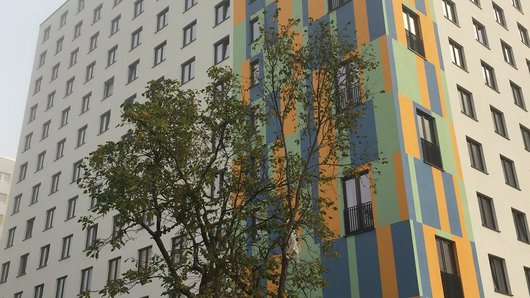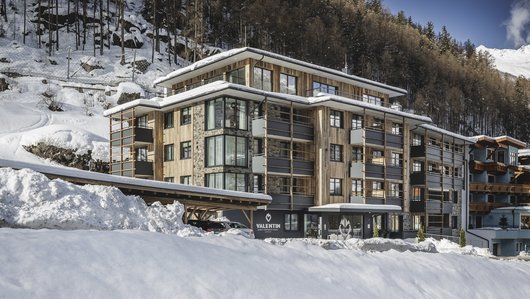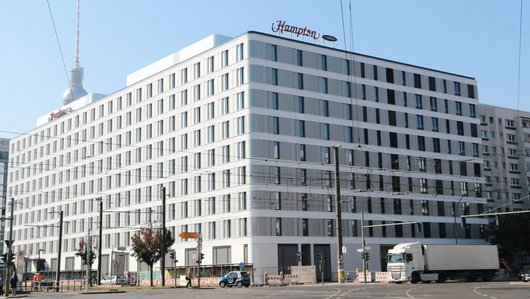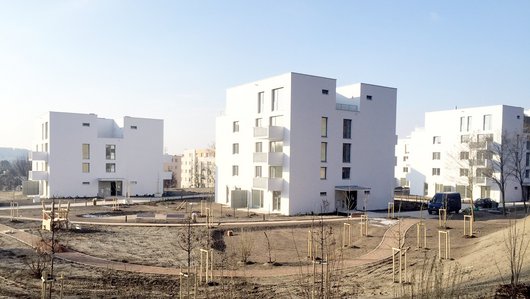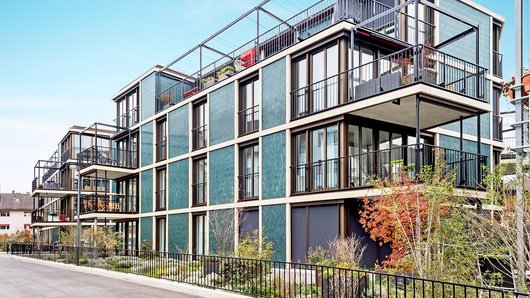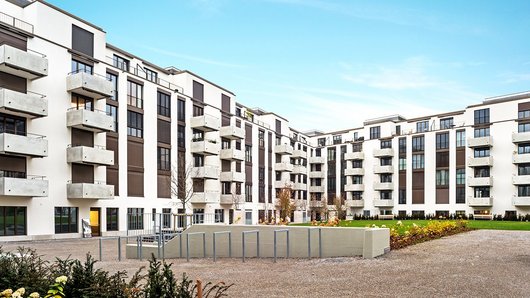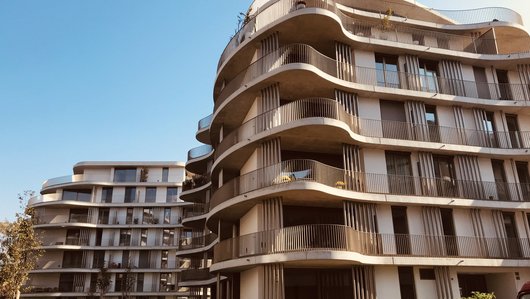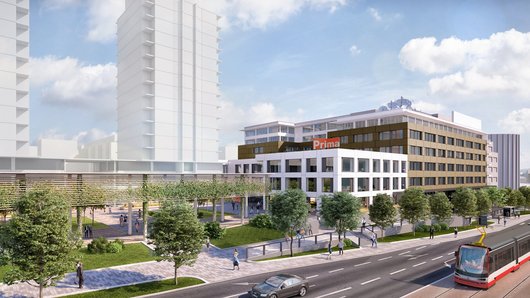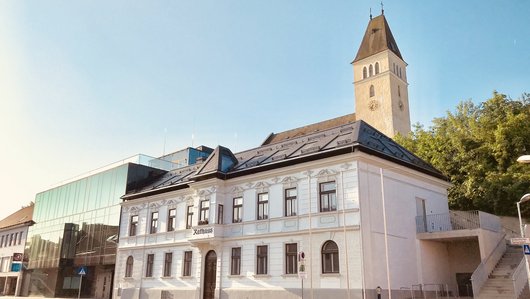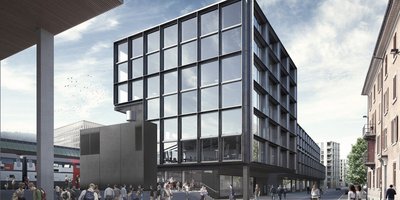
HB Nord - Gleisarena
In the heart of Zurich, right next to the central railway station, planning and construction are underway for the new Gleisarena office block.
With a cramped construction site, difficult foundation conditions, ongoing rail operations, and a specially developed double-curved glass brick facade, the Gleisarena project presented PORR with significant challenges to overcome.
-
EmployerSchweizerische Bundesbahnen SBB
-
ContractorPORR SUISSE AG
-
ArchitectMade in Sàrl, Genf
-
Order typeTotalunternehmer
-
Project typeBuilding construction . Office
-
Project scopePlanning and construction of a seven-storey head end structure and a six-storey longitudinal building
-
Order volume40 million francs (35.9 million euros)
-
Construction start05/2017
-
Construction end02/2020
Overview
Swiss Federal Railways (SBB) contracted PORR to build the Gleisarena office and commercial building in Zurich’s Zollstrasse. Work began on the project in May 2017: a seven-storey head end structure connected to a six-storey longitudinal building via a shared basement. In total, the project comprises 9,000m² of office space on the upper floors and 850m² of restaurant and retail areas on the ground floor. Both buildings meet the Swiss Minergie-P-Eco energy standard and qualify for Gold certification by the German Sustainable Building Council (DGNB).
The project also involves adding a civil protection shelter to an existing pedestrian and utility tunnel, as well as linking the underground level of the Gleisarena to the Gleistribune complex – another PORR project – and to Zurich central railway station’s underground passage.
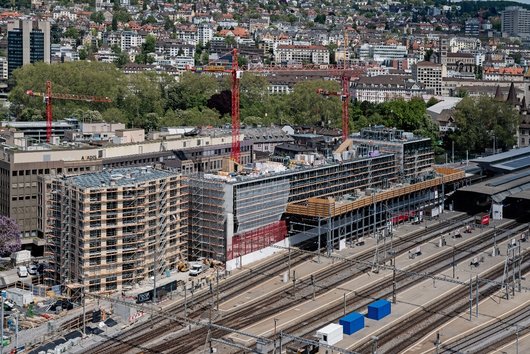

Tight squeeze for the construction pit
In light of the extremely cramped conditions, PORR decided on a reinforced sheet-pile wall to seal the construction pit. Building on experiences from other construction sites in the Europaallee opposite, PORR successfully used vibratory hammers to drive the sheet-piles, using gravel from the nearby Sihl. The sheet-pile walls were strengthened with horizontal steel girders to
maintain their alignment and reinforce them against the diaphragm wall of the existing tunnel. This structure eliminated the need for additional earth anchors and thus saved the considerable costs of installing and subsequently removing such anchors. The construction pit was fully dismantled after completion of the underground level.
A pedestrian/utility tunnel runs beneath a large part of the Gleisarena site, which means the building physics has to ensure that the structure disperses loads appropriately in these tunnel regions as well as into the soil.
Complex foundations by existing tunnel
A pedestrian/utility tunnel runs beneath a large part of the Gleisarena site, which means the building physics has to ensure that the structure disperses loads appropriately in the tunnel regions as well as into the soil. PORR implemented various measures to avoid uneven settling behaviour resulting from different foundation conditions. A total of 49 bored piles, with diameters between 100 and 120cm, were installed beneath the building components that transfer loads into the ground. To ensure even load dispersal and to absorb horizontal loads such as wind or earthquakes, pile caps were bolted together in groups.


The 50 to 80cm thick floor slab for the underground level has a shallow foundation along the outer wall. Over the rest of the building plot, it is set on bored piles due to the high load concentrations. This considerably reduces the degree of settlement and differences in settlement resulting from the tunnel construction.
The dimensions of the pile bolts were chosen such that sufficient bearing surface is available to take up the building loads by means of an elastic bedding.
Horizontal load distribution
The thickness of the ground floor slab varies from 70 to 100cm. It serves for load distribution and to take up horizontal loads across the tunnel roof. The supports in the above-ground storeys are set at an angle, which allows the
horizontal loads to be transmitted through the walls in the core area and front facades and then directed into the floor slab. The horizontal loads are passed through tappets to the bored piles and then into the soil.
The location right next to the main train station and the long, narrow construction site made for extremely tight conditions. The existing tunnel, the electricity supply that crossed the site, and the demanding requirements for the foundations added to the challenges.
Elastic building foundation
The Gleisarena is located right next to Zurich’s main railway station, which has a large number of tracks on several different levels, and is therefore a significant source of vibrations and noise. To compensate for this, the floor slab of the Gleisarena is separated from the foundation structure by an elastomer (elastic polymer) layer.
To ensure the decoupling of both noise and vibration by these elastomers, flat supports are essential. This was achieved by joining the bedding to the pile caps with foundation walers. The walers have a sufficiently large top surface to meet the permitted compressive stress for the specified elastomer.
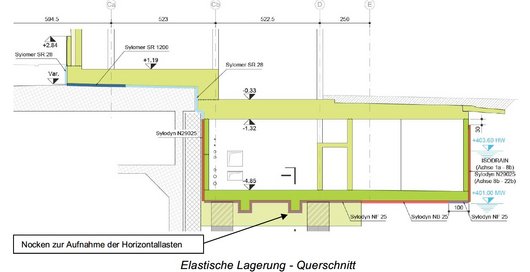

The elastomer bedding is installed above the roof of the tunnel construction and over the pile bolts. Its purpose is to take up the vertical loads from the upper floors: the compressive stress under permanent load when the building is in use can be up to 1500kN/m². In the areas with lower load profiles, a shallow foundation supported on soft elastomer bedding was employed.
The horizontal loads from wind and earthquakes are dispersed into the subsoil via the pile bolts. The floor slab for the underground level has been fitted with tappets in the area where the pile bolts had been installed: the tappets are inset into the pile bolts and serve to disperse the loads. An elastomer has also been installed on the contact surfaces of these horizontal layers.
Redundant conduit block rerouting
The building plan necessitated rerouting a conduit block containing electrical cables for Zurich’s main station and a number of optical fibre cables for various telecommunications providers. Since this included the main power supply for Zurich main station, and rail operations were continuing during the work, a redundant rerouting plan had to be implemented: First, the power supply was switched from the Zollstrasse substation to two other existing substations. The Zollstrasse substation could then be taken out of service and the existing conduit block decommissioned. Once this had been done, the new conduit block was reintegrated back into the grid. On completion of the work, the station was once again supplied with electricity from the Zollstrasse substation.
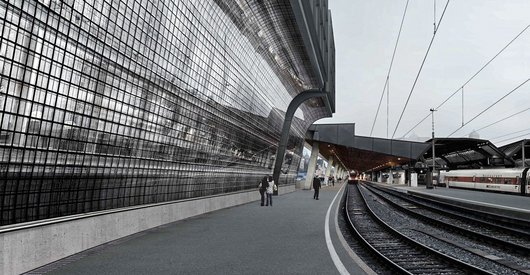

Summary
The Gleisarena project presented PORR with several challenges, all of which PORR rose to beautifully. The location right next to the main train station and the long, narrow construction site made for extremely tight conditions. The existing tunnel, the electricity supply crossing the site, and the demanding requirements for the foundations added to the challenges. Finally, the building was given a spectacular facade facing the main station tracks and curved in two dimensions. This complex one-of-a-kind structure of glass bricks set in a metal framework was developed in-house by PORR.
Technical data
-
Gross surface area14,000m²
-
Building volume9,900m²
-
Excavated volume13,000m³
-
Drilled piles49
-
Reinforced steel1,500t
-
Curved facade1,500m²
-
Post–bolt facade215m²

